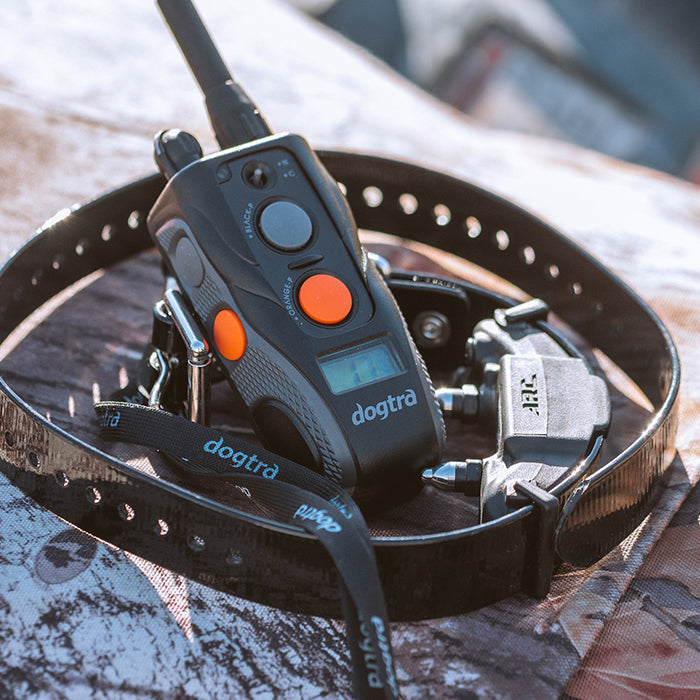HOW USING A TRAINING COLLAR CAN BENEFIT YOUR DOG

I began my training career in 1994. I was working as a vet tech in an animal hospital and had become highly aware that many pet owners had little idea how to teach their dogs to behave properly. At that time, nobody thought of using a training collar. As a result, they were often faced with difficult choices when things spiraled out of control.
I mean, when is the last time you heard of someone relinquishing or euthanizing a perfectly healthy, wonderfully trained dog?
Why Dog Training is Important
Outside of some unforeseen or extraordinary circumstance, it is my experience that healthy, polite, well-behaved dogs live out their lives with the same owner that put in the time and effort to train them.
Good training bodes well for establishing a human-canine bond that will last a lifetime.
The realization of that truth is what led me to a career shift in 1998, leaving behind the medical aspect and launching full-time into the training profession. Solving behavior problems and helping people have a pet they could live with harmoniously became my mission.
Ultimately, that mission is what led me to delve heavily into educating dog owners about the use of remote collars. Prior to getting heavily immersed in remote collar techniques, I had been training with tools considered more “traditional.” I used leashes to manage and influence, did a lot of lure/reward training, and added in corrective slip or prong collars as needed.
Everything seemed to work perfectly fine. But, of course, I was a full-time, professional dog trainer. I trained dogs day-in and day-out for a living. That wasn’t the case for my clients. They were doctors and lawyers, nurses and teachers, bus drivers, and foundry workers. People that put in long days prior to coming home and having to spend time “training the dog.”
How Remote Training Developed
The results didn’t happen as quickly or as easily for them as they did for me. And this is where remote collars started being incorporated into my programs more frequently. People wanted a reliable recall. They wanted the ability to let their dog off leash in the woods or at the beach and feel comfortable Fido would come back when called, and they didn’t want to have to put in months or years’ worth of training time to achieve it.
I was hard-pressed to tell someone, “We’re going to spend 6 - 8 weeks teaching the basic commands, and then we’ll add the e-collar into the training for several weeks so that we can improve reliability in the midst of distraction and eventually be able to go off leash.”
The reality was that for many people getting results as quickly as possible meant the dog got to stay in the home. I found many instances where speed and efficiency in gaining results were of the essence…so I learned how to combine training methods in order to improve reliability and reduce training time. I integrated lure/reward and pressure/release with a leash and body language alongside the use of the e-collar.
The more I did it, the more I become adept at it, and it soon became the norm for me to train with the e-collar. My clients were happy, the dogs were happy, and I was building a business with a reputation for being able to solve people’s dog problems in a way that allowed them to have more enjoyment a lot more quickly.
Do You Need to Train Basic Commands Before E-Collar Training?
So when people ask me if it is necessary to train all the basic commands before using the e-collar, I tell them no, it is unnecessary.
But, it is necessary to know HOW to train those commands without the e-collar. Because if you don’t know how to influence a dog to sit, lie down, walk nicely on a leash, or come to you, the remote collar will not magically do the work for you.
Remote collars provide a way to communicate in an expedient way. I’d compare it to sending a text message to a friend that lives across the country versus sending them a handwritten letter. It is faster and more efficient. However, neither medium is going to do any good without having the knowledge of how to write and communicate. It isn’t the tool that determines the final outcome of the message. It is the knowledge put into the message itself.
Is it wrong to teach all of your commands prior to using the e-collar? Let me assure you there is absolutely NOTHING wrong with that. If you have the time and desire, then do all your pre-training and add in the e-collar for reinforcement later.
And by all means, if you’re a do-it-yourselfer, training your first ever dog, I would suggest you do train the commands in some fashion before you add in a remote collar. If you have some training knowledge already and want to jump to the e-collar, you most likely can. Just be smart about it.
If you feel you’re stuck, then get help. If you want to pre-train some of the commands and start with the e-collar immediately for others…that is okay too.
Final Thoughts
My point is there are not that many hard and fast absolutes. Absolutes are usually created by those who simply haven’t seen, done, or experienced other successful ways of achieving the same outcome. If you want to pre-train all of the commands prior to adding an e-collar into the mix, go for it. That is great! If you have the skill set to incorporate the e-collar as part of the teaching process or a coach helping you train that way, that is great too. The main thing is….
…train your dog!
That way, both of you can enjoy a long, happy, adventure-filled life together.
Happy Training!




